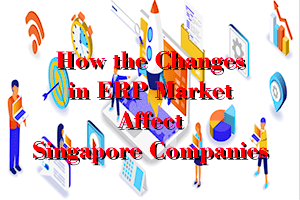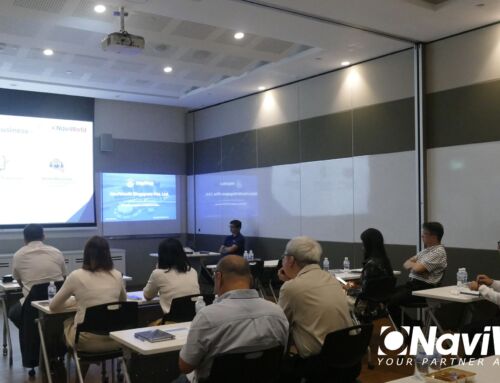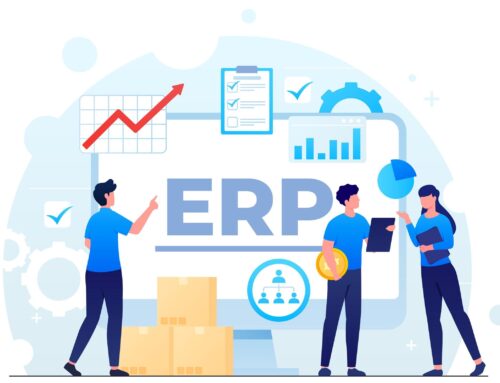
How Do Changes in the ERP Market Affect Companies in Singapore
Introduction
I started my ERP (Enterprise Resource Planning) career when I worked on an ERP project for a manufacturing company in 1996. I was the project manager of the ERP implementation. Subsequently, I joined the ERP industry as a consultant and gradually took on presales, sales, and marketing roles. Eventually, I progressed to the management of ERP business units. During these 24 years of ERP career, I was involved in at least 7 ERP solutions, and this is where I witnessed the changes in the ERP market and how the changes affect Singapore companies.
For about ten years, I was also teaching as an adjunct lecturer in the polytechnics and university on ERP subjects.
Many companies in Singapore had benefitted from the implementation of Enterprise Resource Planning solutions in the last 30 years. However, the ERP market in Singapore had also changed rapidly.
How are the changes in the ERP Market affect companies in Singapore who are looking for an ERP solution? This article explains the history of ERP, its evolution, and how they affect companies in Singapore.
Changes in the ERP Market
So, what had changed? And what are the results of these changes over the years?
The End of the JBOPS
What is JBOPS?
JBOPS was the initials of the top five tier-one ERP software in the market until about 15 years ago. They were:
Those were the most respected tier-one ERPs about 20 years ago. Those were the time when large enterprises were implementing ERP to manage their business operations.
The Decline of Large Enterprise ERP Project
There were limited large enterprises. So, when all of these large enterprises had their ERP implemented, Tier-One ERP’s demand started to decline. The change in the Tier-One ERPs led to the Era of Acquisitions and Mergers amongst the tier-one ERPs. Eventually, Oracle acquired JD Edward, Baan, and PeopleSoft.
Now, only SAP and Oracle provide Tier-One ERPs. Both are still facing challenges in growing their Tier-One ERPs.
Implementing Tier-One ERP is costly and has a long duration. Therefore, very few companies nowadays choose to implement Tier-One ERP.
So, Tier-One ERP companies grew their revenue by acquiring software that supports their ERP. These included the CRM software, Supply Chain solution, Business Intelligence tools, etc. They try to sell these newly acquired supporting software to their existing customer base claiming that they provide seamless integration to their existing tier-one ERPs.
Service providers of Tier-One ERPs generate their revenue mainly from upgrading, support, and customization work.
The Growth of Tier Two ERPs
When the tier-one ERP projects run dry, the ERP vendors started to look for tier-two ERPs for growth. So in 2002, SAP acquired an Isreal company’s ERP and re-branded it as SAP Business One. In 2016, Oracle acquired a mid-market cloud ERP, NetSuite.
Over the years, a company called Infor acquired many of the legacy mid-market ERPs to gain assess to their existing customer base. These include ERPs such as Symix SyteLine, QAD, MAPICS, JBA, Movex. These ERPs slowly faded due to limited R&D funding.
Even non-ERP companies such as Microsoft started to acquire mid-tier ERPs. After the year 2000, Microsoft acquired Great Plain, Soloman, Navision, and Axapta. They were re-branded into Dynamics 365 group of business solutions. Microsoft enhanced them to better integrate to their Microsoft 365/Office 365 products, Azure, and other Microsoft stack of technologies.
The Rise of the Cloud ERP
From 1998 and 1999 onwards, cloud CRM such as SalesForce, cloud ERP such as NetSuite, and Google, generated a lot of hype on cloud solutions.
As infrastructure and technologies become more mature, cloud ERPs are becoming a viable choice for some companies looking for quick and low start-up costs with less IT involvement.
You may want to read more about my previous article about “Cloud ERP or On-Premise ERP” if you want to understand more about their differences.
The Creation of Add-on Solutions
Traditionally, ERP providers built all the functionalities using their internal R&D resources. The consequence is that those modules’ price will be high as the vendor needs to spread the R & D cost amongst a smaller number of users.
Tier-one ERPs with already mature ERP software tend to continue with this approach as they had sunken their R&D investment many years ago. They use these broad functionalities as differentiation against their competitors.
For tier-two ERPs, some of them created their ERPs with the ability to allow their partners to create add-on solutions for specific industries or requirements. These are not customization for particular customers but are standard off-the-shelf add-on solutions certified by the ERP principle.
The strategy of letting third-parties create add-ons helps to reduce the R&D investment on the ERP principles. At the same time, it offers varieties of solutions to meet the needs of some industries. Some of the more popular add-on solutions include bar code mobility solution, retail solution, E-Commerce, etc. You may like to check our add-on solutions on our web site for some of the add-on solutions.
Erosion of Implementation Skill
When there is fewer tier-one ERP new implementation, consultants will have limited experience and knowledge in implementing large and complex projects.
I had the opportunity of interviewing a few tier-one ERP consultants. To my surprise, they have a weak foundation in ERP concepts, even with more than 3-year experience. Most of the time, these ERP consultants were involved in support and enhancement work. Even those who were involved in implementation and project roll-out did not participate in the design process. They were performing as configurators to execute the design provided by the more experienced solution architect.
Problematic Project Cases
In recent years, I came across tier-one projects that went-live but appeared to be incomplete in their implementation.
Another company that I met was doing furniture distribution. They conducted their sales process outside of the ERP. Only when the sale was confirmed, the user will then create the data in the ERP as sales orders.
This erosion of implementation skills in the ERP market is affecting Companies in Singapore. It increases the risk of ERP implementation failure.
IT Graduates form the Majority Pool of ERP Functional Consultants
ERP consultants are grouped into functional consultants and technical consultants.
Functional consultants interview key users, conduct analysis, design the solution, and carry out software configuration. Technical consultants(programmers) perform customizations(programming) of the ERP.
It is understandable that the technical consultants mainly formed by IT graduate as programming skills are needed.
But it is not a good sign when most functional consultants are IT graduates these days.
The Problem
So, what is the problem?
When I first joined the ERP industry more than 20 years ago, most of my colleagues who were functional consultants came from non-IT backgrounds. They were from finance, operations, retail, and I was from manufacturing.
When we encountered customer requirements, we tried to understand the reasons for those requirements first. At times, we could suggest non-software solutions using our accounting or operations knowledge. My seniors had trained me to minimize customization in ERP projects.
IT graduates are good at learning the features and functions of the software. They are trained in System Analysis, which they learn to understand what the customers want and try to replicate that in the software flow. If the consultant cannot replicate the standard ERP software requirement, it often led to customizations. Since IT graduates are more knowledgeable about programming, their preferred solution often results in customization.
Neglect of Project Management
Previously, project management man-days were non-negotiable, and vendors took project management seriously.
But this had changed.
Nowadays, project managers simply understand their role only as project coordinators. Many vendors submit to pressure from customers to lower their project management man-days to win the deal.
Poor and lack of project management are one of the contributing factors to project failures.
Neglect on Consultant Training
A good consultant needs excellent personal and communication skills, which often is not the strength of fresh IT graduates. So ERP consultants are submitted to higher stress than average IT jobs.
Simultaneously, many of their employers tried to load each consultant with multiple concurrent projects to increase the utilization. Many of the consultants work late into the evening each day and often work on weekends. Due to the high workload, maintaining the focus and ensuring the projects’ quality become a strict order.
With such a high utilization rate, there is limited time for learning and training. Poor project management and poor project quality led to frequent fire fighting and used up the consultant’s remaining available time.
These working conditions led to a high attrition rate in the ERP industry.
When it became difficult to retain consultants and reduce profit margin, employers are hesitant to spend resources and time in training. The result is even more project problems and added on to the cause of the high attrition.
ERP consultants are often face frequent customer complaints and long working hours, and it will be tough to retain. Only the committed and those who can derive job satisfaction will stay in this industry for the long term.
From my experience, it will take more than one year of training and mentoring before a fresh consultant can work independently. The long period of consultant training is an investment that many ERP vendors cannot afford.
Lack of Quality Consultants
Due to the limitation of providing consultants with training, some vendors pair their experienced solution architects with less experienced consultants. The more experienced solution architects will do the analysis, design the configuration, and then pass to the consultant to carry out the configurations.
I had opportunities for interviewing consultants working in this type of work arrangement. Although they had more than three years of ERP experience, I was surprised by their lack of fundamental ERP knowledge. Their lack of essential knowledge is because they did not have the chance to do the analysis and design works.
Although I still interview experienced consultants, I found it difficult to recruit them. Their knowledge does not match up to their years of experience.
With the more experienced solution architects exiting the market, the remaining consultants will have minimal understanding of the ERP.
ERP Software Price Getting Cheaper as Compare to their Services
Reduced Software Costs
You may not realize that many of the ERP software prices have been dropping over the last 20 years. Many of the ERPs that have been in Singapore for more than 20 years have priced their license in USD. Since Singapore was a third-world country 2o years ago, many of them set the Singapore pricing as part of the Asia third-world-country price.
Not many of you can remember that more than 20 years ago, the USD to SGD exchange rate was more than 1.8. Now, this has dropped to as low as 1.33. So, effectively, the license price for ERP in Singapore has reduced over the 20 years. In some instances, Singapore ERP license prices can be lower than the prices in China and India due to the additional software localization requirement.
Increased Labour Costs
During the same period, labor costs increased. The increase in labor cost and reducing software cost makes Singapore a unique ERP market when comparing the ratio of services cost vs. software cost. In most countries, the cost of the service vs. software cost is about 1:1. In Singapore, it is often 2:1 or even more.
The cost of ERP services in Singapore contributes to a significant part of the total ERP project cost. Therefore, customers often pressure the vendors to reduce the cost of the services instead of the license. The pressure to lower consultant services price resulted in the stagnation or even reduced consultant man-day rate over the years. ERP consultants’ salaries had stagnated or reduced over the years. The low consultant salary is making it challenging to recruit and retain talents in the industry.
These changes in the ERP price of licenses and services had affected the quality of ERP consultants in Singapore.
Globalization of Implementation Services in Singapore
Singapore, as a country, is an attractive market for consultants from low-cost countries. This leads to easy access to overseas ERP resources, and it has globalized ERP consultants in Singapore. Many of the ERP consultants are now non-Singaporean. The increasing employment of foreign talent is due to the difficulty of recruiting and retaining Singaporeans in this industry. The situation is made worse by the relatively lower remuneration and high-stress working environment. With the stagnation of consultant man-day rates, ERP vendors turn to lower-cost foreign talent consultants to maintain their margin.
Normalization of Customization
When I first started in the ERP industry, my managers often discourage the heavy customization of their ERP project.
However, nowadays, I see more projects that were heavily and even unnecessarily customized.
Various reasons led to this situation:
- Some customers expect the software to replicate their existing workflows.
- Consultants who are from IT background tend to choose customizations for their solutions.
- Vendors use customization profit margin to recover the initially quoted low price.
- Some vendors use heavy customizations to lock-down their customers and to charge higher support prices.
- Some vendors and consultants have pride in their ability to customize their projects. Sometimes, they will convert these customizations into add-ons or re-sell the customizations to other customers.
Often, programmers do the quick and dirty way by hard coding their customizations. These quick fixes will take up lesser effort in programming and make the software more complicated when changes are required.
You can learn about ERP customization from my article on “Why You Should Minimize Customization in ERP Projects.”
The Emerging of an IT Selling Strategy call “Increase Stickiness”
In the last few years, the phrase “Increase Stickiness’ is becoming common in the IT industry.
The aim is to find ways to make the customers stick with the IT vendors.
The increased in stickiness is often achieved in a few ways:
- Cloud solutions that when customers stop paying, they will lose the use of the software.
- Heavy customizations that made it challenging for customers to find an alternative vendor.
- Hard code in customization making the need for the customers to go back to the vendor for changes
I am not in favor of such tactics. In the end, both vendors and customers will be the losers.
Increased ERP Project Failure or Incomplete Implementation
So, how do these changes affect Singapore companies who are looking for an ERP solution?
The result is an increase in the risk of project failure and project cost overrun. Customers often ended with a buggy ERP system that the users had to make do with it.
The following are some of the incomplete ERP projects that I encountered in the last few years:
- Implementation did not include security training and setting. All the users were set as superuser permission and were able to access sensitive information in the system.
- The consultant did not design the financial statements, and the vendor told them that their project had already gone live. They will set up the financial statements only if the customer signs a support contract.
- Instead of including implementing the standard reporting in the ERP, some vendors prefer selling third-party reporting tools to their customers.
The disappointing part of all these changes in the ERP market is the normalization of incomplete and failed projects. Some vendors are taking unfinished and failed projects as a norm rather than exceptions. With such a mindset, the quality of ERP implementation will continue to be unsatisfactory.
My Advice
What is my advice to Singapore companies when the ERP market is going through changes?
- Consider cloud ERP since it is becoming more mature and affordable. Calculate your breakeven and future cost before embarking on it. Make sure that there is a plan B of on-premise and alternate implementation partners for the solution. You can read my previous article on “Cloud or On-Premise” for more information. Cloud ERPs tend to favor companies that have fewer users and with a less complicated requirement.
- Avoid Big Tier-One ERPs. Companies cannot afford lengthy multi-year implementation when the business environment is evolving rapidly. The high cost and low quality of consulting services will make implementing big ERP risky and with little ROI.
- Implementation Quality is at least as necessary as the software. 90% of troubled projects that I encountered were due to poor implementation. Only 10% were due to companies selecting the wrong ERP.
- Do not employ one internal ERP person to implement your project full time. It is unlikely that you will be able to recruit and retain a competent ERP person internally. Even ERP vendors like myself are finding it challenging to hire excellent and experienced consultants. How can a company without the product knowledge be able to evaluate the quality of the ERP candidates? Furthermore, ERP implementation leverage the extensive experience and expertise of a competent team of consultants. Even a very experienced consultant needs input and ideas from other consultants.
Conclusions
It took me ten years to understand the ERP concept of Material Requirement Planning and Manufacturing Resource Planning (MRP and MRP II). I often share, “If you assume you know a lot when you are not, it is dangerous.”
ERP implementation is not a typical IT project. It takes a long time to groom a good ERP consultant and even more challenging to retain them.
ERP project directly impacts the performance of a company. During my 20 years of ERP career, I have seen a company went bankrupt after implementing the “World’s Best ERP”.
The ERP market has changed rapidly over the year, and it will continue to change in the years to come. Understanding how these changes will help you to understand why and how they affect companies in Singapore.
The vast options of established ERP solutions available in Singapore, such as Microsoft Dynamics 365 Business Central and SAP Business One, are making it easy for companies to select and implement suitable ERP. If the choice is overwhelming, you may like to read my previous article on “How to Select ERP for SME” for more information.
If you like to discuss this topic, please do not hesitate to contact us.
Posted 29 May 2020



